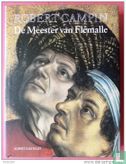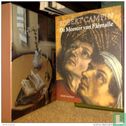Book with many color illustrations, large format.
His life
Campin, Robert (c. 1378 - Tournai April 26, 1444), Hainaut painter, worked from 1406 in Tournai, where he was first mentioned as a burgher in 1410 and where he carried out numerous commissions, mostly of a decorative nature, as a city painter. Except perhaps one mural, there is no known work of which Campin's authorship can be proven on the basis of documents. According to Tournai records, in 1427 he was apprenticed to 'Rogelet de le Pasture', usually identified with Rogier van der Weyden, and Jacques Daret. Some panels (in museums in Berlin, Paris and Lugano) of an altarpiece by Daret are known, painted for the Abbey of St. Vaast near Atrecht. They are stylistically very related both to some works by Rogier van der Weyden and to a number of panels attributed to the Master of Flémalle. Since Daret was a pupil of Campin, the latter is plausibly identified with the Master of Flémalle on the basis of that relationship. It is thus named after two large panels, probably from Flémalle: Mary with Child and Saint Veronica (with The Holy Trinity on the back), both in the Städelsches Kunstinstitut, Frankfurt. The main other works attributed to the same artist on stylistic grounds include the famous 'Merode Triptych', the central panel of which is The Annunciation (Metropolitan Museum of Art, The Cloisters, New York), further The Nativity (Musée des Beaux-Arts, Dijon). An early work, The Entombment, is in the collection of Earl Seilern, London. His last period includes an altarpiece, dated 1438 (Prado, Madrid), which was painted for Heinrich Werl and which comes closest to the art of Rogier van der Weyden. The style of Robert Campin or the Master of Flémalle forms the transition between the so-called international style of the last decades of the 14th century and the so-called realism of the Dutch masters of the 15th century. Plastic design and monumentality are main characteristics of his art, which appears more 'primitive' than that of Jan van Eyck, although both worked around the same time. The identification of the Master of Flémalle with Robert Campin is not accepted by all art historians. Some, such as Max J. Friedländer, regard the works attributed to the Master of Flémalle as youth works by Rogier van der Weyden. In the 1930s there was fierce polemic about this between Emile Renders, who advocated the latter theory, and Leo van Puyvelde, who saw in the Master of Flémalle a distinct and older artist. Many other art historians have devoted their attention to this problem. However, the identification of the work of the Master of Flémalle with the young Rogier van der Weyden has had fewer followers since the 1960s.
This text has been translated automatically from Dutch
Click here for the original text
Boek met veel kleurenillustraties, groot formaat.
Zijn leven
Campin, Robert (ca. 1378 - Doornik 26 april 1444), Henegouws schilder, was vanaf 1406 werkzaam te Doornik, waar hij eerst in 1410 als poorter werd vermeld en waar hij als stadsschilder tal van opdrachten, meestal van decoratieve aard, uitvoerde. Behalve wellicht één muurschildering, is geen enkel werk bekend waarvan het auteurschap van Campin aan de hand van documenten kan worden bewezen. Volgens Doornikse archiefstukken gingen in 1427 bij hem in de leer 'Rogelet de le Pasture', die meestal met Rogier van der Weyden wordt vereenzelvigd, en Jacques Daret. Van Daret kent men enkele panelen (in musea te Berlijn, Parijs en Lugano) van een altaarstuk, geschilderd voor de abdij van St.-Vaast bij Atrecht. Zij zijn stilistisch zeer verwant zowel met sommige werken van Rogier van der Weyden als met een aantal panelen die aan de Meester van Flémalle worden toegeschreven. Aangezien Daret leerling was van Campin, wordt deze laatste op grond van die verwantschap op aannemelijke wijze vereenzelvigd met de Meester van Flémalle. Deze wordt aldus genoemd naar twee grote panelen, waarschijnlijk uit Flémalle afkomstig: Maria met Kind en De Heilige Veronica (met op de rugzijde De Heilige Drie-eenheid), beide in het Städelsches Kunstinstitut, Frankfurt. Tot de voornaamste andere werken die op stilistische gronden aan dezelfde kunstenaar worden toegeschreven, behoren het beroemde 'Merode-triptiek', met als centraal paneel De annunciatie (Metropolitan Museum of Art, The Cloisters, New York), verder De geboorte van Christus (Musée des Beaux-Arts, Dijon). Een vroeg werk, De graflegging, bevindt zich in de verzameling Graaf Seilern, Londen. Tot zijn laatste periode wordt een altaarstuk gerekend, 1438 gedateerd (Prado, Madrid), dat voor Heinrich Werl werd geschilderd en dat het dichtst de kunst van Rogier van der Weyden benadert. De stijl van Robert Campin of de Meester van Flémalle vormt de overgang tussen de zgn. internationale stijl van de laatste decennia van de 14de eeuw en het zgn. realisme van de Nederlandse meesters van de 15de eeuw. Plastische vormgeving en monumentaliteit zijn hoofdkenmerken van zijn kunst, die 'primitiever' aandoet dan die van Jan van Eyck, al hebben beiden omstreeks dezelfde tijd gewerkt. De identificatie van de Meester van Flémalle met Robert Campin wordt niet door alle kunsthistorici aanvaard. Sommigen, zoals Max J. Friedländer, beschouwen de aan de Meester van Flémalle toegeschreven werken als jeugdwerken van Rogier van der Weyden. Hierover werd in de jaren dertig heftig gepolemiseerd tussen Emile Renders, die deze laatste theorie voorstond, en Leo van Puyvelde, die in de Meester van Flémalle een aparte en oudere kunstenaar zag. Vele andere kunsthistorici hebben hun aandacht gewijd aan dit probleem. De identificatie van het werk van de Meester van Flémalle met de jonge Rogier van der Weyden kent echter sinds de jaren zestig minder aanhangers.











